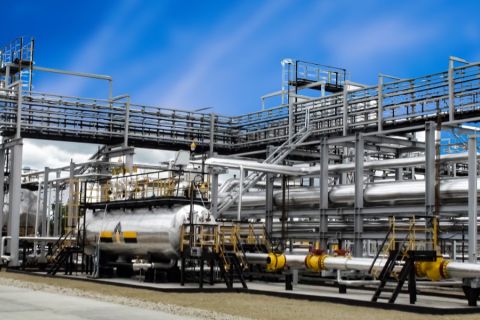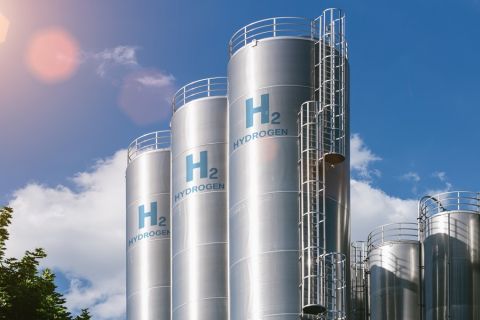Some 100 miles north of Los Angeles, over the Tehachapi Mountains, lies the southern end of the San Joaquin Valley and Kern County. Here, multibillion-barrel oil fields like Midway-Sunset and Kern River sprang up around 1910. Today, this oil-rich county is no less important to the energy needs of California-for it is here that roughly 550,000 barrels per day of the state's total 800,000 daily barrels of oil production takes place. This daily outpouring of black gold may seem sizeable, but it's just a drop in the bucket in a state that has become absolutely delirious in its love affair with the automobile. In fact, the pump-island binge of the citizenry of California-where rush hour can now be experienced 24 hours a day-accounts for the vast majority of the state's estimated 2.1 million barrels per day of current crude consumption. In the face of such demand, but comparatively little new drilling being permitted, Kern County's oil and gas operators are faced with the challenge of coming up with new and smarter ways to add reserves and production from existing asset bases, and of operating more efficiently so that their development dollars stretch over more barrels of output. In the end, they're faced with maximizing profitability in a contradictory environment that on one hand encourages oil and gas consumption, but on the other, eschews the opportunity to add to energy supply-this in a state that has an estimated 60 billion barrels-plus of remaining oil in place. Some operators haven't been able to meet these challenges and have wound up throwing in the pumpjack towel. Other independents, however, have been able to make opportunistic acquisitions, engineer better ways to exploit them and, in the process, improve bottom-line performance and shareholder value. Occidental Petroleum By February 1998, when Los Angeles-based Occidental Petroleum Corp. (NYSE: OXY) acquired the U.S. government's Elk Hills reserves near Taft, California, some 1.5 billion barrels of oil equivalent (BOE)-out of an estimated 6 billion equivalent barrels of original oil in place-had already been produced there since the drilling of the field's first discovery well in 1910. "What our ultimate recovery will be, only time will tell-but this is a huge resource for us to exploit, in terms of increasing production, adding reserves and shareholder value, " says John M. Allen, president and general manager, Occidental of Elk Hills Inc. Since the $3.5-billion purchase of 425 million BOE of proved reserves at Elk Hills was made five years ago, the Oxy upstream unit has been tenacious about achieving these objectives. The result: while it has produced 169 million equivalent barrels of oil there, it has added 184 million BOE of reserves-bringing current proved reserves at Elk Hills to 440 million BOE. Moreover, during this period, the efforts of the Oxy unit have allowed the company to recover almost 80% of its initial acquisition cost. How was this achieved? The devil is in the details. Drilling "When we acquired the 75-square-mile property, there were 1,000 producing wells," says Edward J. Hanley, exploitation manager, Occidental of Elk Hills. "Since then, we've drilled or redrilled more than 700 new wells-165 alone last year-and returned another 200 existing wells to active service. This has allowed us to both grow production and build reserves." Indeed, current daily sales from what is now 1,800-plus active wells average 127,000 equivalent barrels versus 80,000 BOE in 1997-just before the acquisition. The wells produce from five reservoirs that range in depth from 1,600 feet to more than 12,000 feet, with the shallow-oil zone at 3,000 feet and the Stevens Zone at 6,000 feet the most productive. "Because each of these reservoirs is very complex, consisting of many layers and fault blocks, there are literally hundreds of reservoirs to understand and exploit," says Allen. "This was the fundamental opportunity we saw at Elk Hills. And we've been willing to do the very detailed work to redevelop many of these reservoirs. That's why we've been able to successfully replace 109% of our cumulative production during the past five years." To better understand the complex geology beneath Elk Hills, the company has built a Star Trek-like 3-D visualization center at the site that displays on a giant 20- by 6-foot screen a virtual reproduction of the field's subsurface. "Originally, we thought the center was going to be used as an exploration tool to find more oil in the unit-and it is in fact doing just that," explains Hanley. "But its most profitable use has been in the surveillance and management of the reservoirs where we have existing production. Here, with the help of an interdisciplinary team of geophysicists, petrophysicists, geologists, reservoir, drilling and production engineers, we've been able to remap how various reservoirs are laid out and redesign our waterfloods to capture oil that would not have been recovered by previous waterflood designs." The center is also aiding the company's exploration efforts. Besides Oxy's planned drilling of 180 development wells this year, it also will spud up to four exploratory wells below the Stevens Zone. Says Hanley, "We're now able to look deeper, around the perimeters of productive formations; we need to because we've already focused on the easy-to-find oil on the crest of those formations." Gas Facilities While Oxy of Elk Hills produces 52,600 barrels per day of mostly medium-gravity oil, its daily output also includes 387 million cubic feet of natural gas and 18,000 barrels of natural gas liquids. "We are, in fact, the largest natural gas producer in California, with three gas-processing plants that have a collective processing capacity of 450 million cubic feet per day," says Allen. Between 1998 and 2000, the Oxy unit put a lot of effort into improving the performance of those plants, as well as its gas-compression facilities. It added, for instance, 40,000 horsepower of gas compression in the field to the 100,000 horsepower that already existed in 1998. "This allowed us to take advantage of market opportunities for increased gas sales in 2001, when prices spiked to an average $10 per million Btu (MMBtu) for the year." Power While the increased price of natural gas has squeezed the margins of many other operators that use large amounts of third-party power for enhanced oil recovery operations, Oxy of Elk Hills has minimized its exposure to this rising cost of business. "With an on-site cogeneration plant, we generate the majority of the power needed to run the field's electric-driven pumpjacks, some 30,000 horsepower of electric-driven gas compression, and the surface pumping equipment needed for injecting fluids downhole," says Bruce A. Macdonald, production operations manager. "While we use about 52 megawatts of electricity daily, we generate an average 45 megawatts. So our exposure to buying higher-priced, third-party power off the grid is greatly reduced." Automation Today, nearly 1,500 of the producing wells at Elk Hills need artificial lift. These wells require pumps, rods and surface equipment-all of which wear out and demand constant surveillance, says Macdonald. "The way that surveillance was done in 1998, people came to work, got in their pickups, grabbed a clipboard with a list of wells to visit, then drove around all day, looking to see which wells were producing and which weren't. As long as the pumping-unit arm was going up and down, nothing appeared abnormal-but they couldn't tell whether or not the well was producing at an optimum rate." Today at Elk Hills, far fewer people come to work to run around monitoring wells. Instead, they go into a control room in the field and sit down in front of a computer that provides performance data on each of the field's 1,492 pumping units, its 150 injection wells and most of its 120 flowing wells. The operator knows at a glance which wells have broken and which aren't producing optimally. "The consequence of having all this automation-installed at a cost of around $9 million-is that we've greatly reduced the number of hours we spend on servicing wells with maintenance rigs, from about 10,000 hours per month to 8,000," says Macdonald. "That's because the computer-automation system allows us to anticipate when failures are likely to occur and to schedule the necessary repairs before a more costly maintenance-rig operation is needed. From this perspective, we calculate we're saving about $400,000 per month in rig costs. In addition, the result of doing preventive maintenance versus more costly and time-consuming repairs later on is that problem wells are offline less." Acid Stimulation A key part of the growth in Oxy's output since taking over at Elk Hills has been stimulating the productivity of wells after they're drilled. Case in point: the 6,000-foot Shale reservoirs-part of the Stevens Zone and one of Oxy's major exploitation targets when it made the Elk Hills acquisition. "When we came here, the underdeveloped Shale reservoirs accounted for only 10% of total oil and gas production; today, they represent nearly one-third of our daily output, on an oil equivalent basis," says Allen. "This doesn't mean the initial Shale wells we drilled had great flow rates; on the contrary, many didn't produce at rates sufficient to make the drilling program sustainable. So we experimented with fracturing and acidizing and found that acid worked very well. "In fact, acidizing-which unblocks the flow of oil and gas into the wellbore-has accounted for upwards of one-half the production gains we've realized from these reservoirs." The cost effectiveness of acidizing these reservoirs has been enhanced by the fact that the acid is pumped into the wells using coiled-tubing units instead of workover rigs. Also, because these acidizing jobs are very large and Oxy acidizes lots of wells, it has become a major acid consumer. That gives it market leverage, which it has begun to use. Hanley points out that Oxy's total acidizing costs at Elk Hills last year dropped to $12 million from a prior-year level of $16 million. "This year, we're looking for another 5% to 10% in cost savings." Margins For its mainly 26- to 35-degree API gravity crude output at Elk Hills, Oxy receives an average $4-per-barrel discount to the prevailing market price for lighter West Texas Intermediate crude which, since July 1, 2002, has ranged from $34.61 to $25.19 per barrel. "Backing out another $4 per barrel for operating and G&A costs, our cash margin on Elk Hills crude during that period has ranged from $26.61 to $17.19 per barrel," says Hanley. On the natural gas side, Oxy of Elk Hills has been able during the same time frame to sell its gas at the SoCal border price, which ranged from $5.31 to $2.58 per MMBtu. Backing out operating and G&A costs of 61 cents per MMBtu, the Oxy unit's cash margin on its gas during that time ranged from $4.70 to $1.97 per MMBtu. Berry Petroleum A nearby Bakersfield-based independent that has been around for about 100 years, publicly traded Berry Petroleum Co. (NYSE: BRY) continues to devise more efficient ways to tap the remaining heavy-oil potential of its core area of operation-the mature Midway-Sunset Field not far from Taft. There, the producer, with reserves of 100 million barrels of oil and gross production of 16,500 barrels per day, operates 80% of its 2,200 wells. "To get that thicker-than-maple-syrup oil out of the ground at Midway-Sunset, an operator has to use thermal recovery, which involves generating steam, injecting it into the ground and heating the oil; that reduces the oil's viscosity and allows it to flow into the wellbore," explains Jerry V. Hoffman, chairman, president and chief executive officer of the $360-million-market-cap company. "So by far, the biggest part-40% to 45%-of our $8.50-per-barrel operating cost in the field is steam." To reduce its cost of steam, Berry uses cogeneration technology. "We produce and inject 65,000 barrels per day of steam in the field, and 40,000 barrels of that comes from cogeneration," he says. A cogeneration plant takes natural gas and burns it to spin a turbine, which generates electricity that can then be sold; the exhaust heat from that process then goes to a boiler to generate steam. "The way we see it, our primary product from this process is steam," says Hoffman. "The electricity is simply a by-product, and whatever we get from selling that by-product offsets our steam costs." Given that it takes four barrels of steam to get one barrel of oil out of the ground at Midway-Sunset-and that the offset of standard-offer (electricity sales) contracts with utilities reduces steam costs to 75 cents per barrel-it costs Berry an average $3 for every barrel of heavy oil it produces. If the company solely used conventional steam boilers, where gas is burned and only steam is generated, it would be facing a per-barrel steam cost of $2, or $8 to extract one barrel of oil through thermal recovery. The second-biggest technology Berry is using to reduce operating costs at Midway-Sunset is horizontal drilling. Conventional vertical wells there cost about $125,000; horizontal wells, about $200,000, says Hoffman. "However, a horizontal well, because it's extended over a long lateral area and exposes more productive pay, will take the place of three to four vertical wells. So we wind up realizing a big decrease in operating costs and a big increase in capital efficiency. "One of the things we really focus on is return on capital employed. During the past three years, it has averaged 17% annually." With 2,200 wells, most of them cyclic-steam operations, Berry is faced with the need for continuous well-servicing jobs that annually require 10 to 14 rigs to de-sand wells and change pumps. However, it has turned that need into another cost-saving opportunity. "We've found that by forming multiyear arrangements with just one service company-not three or four vendors in different places-we get better pricing on our service contracts for that amount of work," says Brian Rehkopf, Berry vice president of engineering. "Also, we get the opportunity to take any improvements in field practices the service company may make at Midway-Sunset and transfer them to our operations at North Midway-Sunset or our Placerita Field in the northern part of Los Angeles County." The company is also driving down the cost of chemicals needed to treat its heavy-oil production to make it saleable, says Rehkopf. "By arranging with a chemical contractor to charge us so much per barrel for every barrel of cleaned-up oil he puts into our sales line, we've incentivized him to be as cost effective as possible." The result: whereas Berry's annual chemical costs used to run $1.4 million, they're now $660,00 to $700,000; meanwhile, its daily production has climbed from 13,000 to 16,500 barrels per day. Despite these strides, Berry isn't relying solely on California for future growth opportunities. "With all the consolidation that has gone on within the past four to five years, the opportunities for acquire-and-exploit independents like ourselves have become very limited," says Hoffman. For this reason, Berry is looking to develop new core areas in Canada's Western Sedimentary Basin and in the Midcontinent region of the U.S. Last year, it purchased from El Paso Energy for $3.4 million some 110,000 acres in the Forest City and Cherokee basins of Kansas, with the aim of exploiting those regions' coalbed-methane potential. Says Hoffman, "Buying and developing natural gas reserves provides us a natural hedge, given that we have to buy so much gas to generate the steam for our current core heavy-oil operations." Ivanhoe Energy With its head office in Vancouver, and U.S. upstream operations based in Bakersfield, publicly traded Ivanhoe Energy Inc. (Nasdaq: IVAN; Toronto: IE) is also pursuing ways to more efficiently exploit the low-gravity crude potential of Midway-Sunset. This is where the bulk of its 2 million barrels of oil reserves are and where it's currently producing 575 barrels per day of heavy oil from 34 wells. The company also has a 42% participation with Aera Energy in the nearby deep Temblor gas play, 250 barrels of daily oil output from West Texas wells, an interest in the East Texas Bossier play and involvement in a major gas-to-liquids project in Qatar. (For more on this, see "Gas-to-Liquids," Oil and Gas Investor, July 2002.) "The way we've chosen to improve margins is to increase our production and hence, spread operating costs over larger volumes of output," explains Ed Veith, chief reservoir engineer for Ivanhoe's U.S. upstream division. In the fall of 2001, the operator conducted a five-well, pilot cycle-steam project at Midway-Sunset. "We took flared lease gas that was being wasted, converted it to steam through a portable steam generator, injected the steam down the producing wells, let the heat dissipate into the productive formations, then produced back the heated oil," he says. "That increased total daily output from the five wells to 240 barrels from 90 barrels-all without having to purchase any natural gas to fuel the steam project." Based on this result, Ivanhoe installed a casing-gas collection system last May at a cost of $500,000 to more efficiently gather lease gas-as well as a fuel and water distribution system-and began a full-scale, 20-well, cycle-steam project in the field that has helped boost daily oil output to current levels. Says Veith, "Through a planned $4- to $5-million southern expansion development program in the South Midway-Sunset Field-involving yet another 20-well program-we expect using cycle-steam recovery to double our current reserves and daily production in the region." Increased production isn't the only driver of the operator's improved margins. Since 2000, when the company first started developing the field, it has reduced drilling and completion costs by about 20% to $138,000 per well. "We've accomplished this through a better understanding of the reservoirs and knowing where the tops of the sands are," says Veith, who was a reservoir management engineer for Aera Energy. Looking to maintain optimum production levels, the producer also uses dynamometers in the field to measure whether each well is pumping at capacity. "It only costs us about $700 per month to sweep our 34 wells with this tool, so it doesn't take many barrels of production to recover our outlay-and we always find some problem that can't be seen without this tool." Again, in an effort to leave no recoverable barrel of oil behind, the company also injects foam diverters into wells slated for cycle steaming. "A foam diverter is a surfactant like soap which, when introduced downhole, expands into a foam to steer the injected steam into the targeted formation," says Veith. "It's just another way to enhance oil recovery." With this focus of maximizing production, Ivanhoe has become one of the lower-cost operators in Kern County. Recently, it has been selling its Midway-Sunset heavy oil output at $27 per barrel-about a $7-per-barrel discount to WTI; after operating costs and G&A expenses of $6.70 per barrel, its cash margin has been running $20-plus per barrel. Macpherson Oil Back in 1974, Santa Monica-based Macpherson Oil Co., then focused on oil production from waterfloods in Alabama, saw that the major oils in California were selling what they considered marginal producing properties in Kern County. So the private independent latched on to some of these discards-in the Midway-Sunset Field, Mount Poso and Coffee Canyon, which is part of Round Mountain Field. "Clearly, one of the major assets that was being sold was Round Mountain Field," recalls company president and chief executive officer Donald Macpherson. "We purchased the north end of the field, while Texaco retained the center, and Shell, the south end. Although primary production in the entire field at the time was about 1,000 barrels per day of 12- to 20-degree API gravity oil, we saw it as a prime candidate for thermal development." Shell, he notes, had already implemented a successful steam-flood project at nearby Mount Poso-and Round Mountain was a mirror image of that field. While the subsurface horizon with the greatest potential for thermal development was the 2,000-foot-deep Vedder Zone, it hadn't been tapped because of the then-existing checkerboard ownership at Round Mountain. Between 1986 and 1992, Macpherson purchased Shell and Texaco's ownerships there and in 1996, unitized the field. When the company began thermal recovery in 1998, primary oil production from the field had dropped to 600 barrels per day; today, through steam-flooding, output from the field has risen to 4,500 barrels per day from 120 wells. Overall, the company has 180 active wells throughout Kern County. Macpherson Oil's thermal-recovery approach? "The Vedder is a high-aquifer reservoir," explains production engineer David Niewiara. "So we've placed steam-injection wells updip along the controlling fault and high-volume submersible pumps downdip to dewater the field and drop the bottomhole pressure. This allows the steam chest to expand from updip to downdip, resulting in high oil-recovery rates." While some Kern County operators might be content with daily heavy-oil output of 4,500 barrels, Macpherson isn't. "Within the next year or so, our heavy-oil output at Round Mountain should increase to more than 6,000 barrels per day." He expects to achieve this by injecting more steam into the ground, which will move more oil; by installing more high-volume lift; and by drilling more infill wells to capture the oil as it moves from updip to downdip. During the primary production life of Round Mountain, which dates back to the 1920s, about one-third of the field's 100 million barrels of oil in place was recovered, observes Macpherson. "We expect through ongoing improvements in our thermal-recovery program to ultimately recover from the Vedder another 22- to 27 million barrels of oil. This is in addition to the lighter-oil potential that exists in the shallower Pyramid Hills Sand, which is amenable to waterflooding." Since the independent is using conventional gas-driven steam generators for thermal-recovery, it tries to mitigate price risk through hedging, buying strips of natural gas when prices are low in the shoulder months. This, in turn, lowers the cost of its steam. Additionally, in a move aimed at upgrading its steam generators, the operator is putting new convection sections on them, which will allow for a more efficient transfer of heat in the generators. "Effectively, we wind up getting more steam for fewer Btu of energy, which further reduces our steam costs," explains Macpherson. "In fact, in one of our six generators, where we've installed a more efficient convection section, [heat-transfer] efficiency has improved from 77% to 90%. That has translated into a monthly cost savings of $30,000." The producer is also attempting to lower electrical costs by installing variable-speed motors on its high-horsepower pumping equipment. Through use of these motors, electrical usage is directly correlated to the amount of horsepower actually needed to produce a well or to run a water-disposal pump at any given time. Adds Macpherson, "We've also done computer-simulation models of thermal development in a reservoir, which is helping us to evaluate the most cost-efficient way to maximize production and margins."
Recommended Reading
Markman: Want CO2 Gone Now? Well, You Don’t Always Get What You Want
2024-04-29 - A slew of scenarios shows that climate goals can be achieved with the use of fossil fuels and CCUS.
No Silver Bullet: Chevron, Shell on Lower-carbon Risks, Collaboration
2024-04-26 - Helping to scale lower-carbon technologies, while meeting today’s energy needs and bringing profits, comes with risks. Policy and collaboration can help, Chevron and Shell executives say.
Could Concentrated Solar Power Be an Energy Storage Gamechanger?
2024-03-27 - Vast Energy CEO Craig Wood shares insight on concentrated solar power and its role in energy storage and green fuels.
Tangled Up in Blue: Few Developers Take FID on Hydrogen Projects
2024-04-03 - SLB, Linde and Energy Impact Partners discuss hydrogen’s future and the role natural gas will play in producing it.
Google Exec: More Collaboration Needed for Clean Power
2024-04-17 - Tech giant Google has partnered with its peers and several renewable energy companies, including startups, to ramp up the presence of renewables on the grid.





